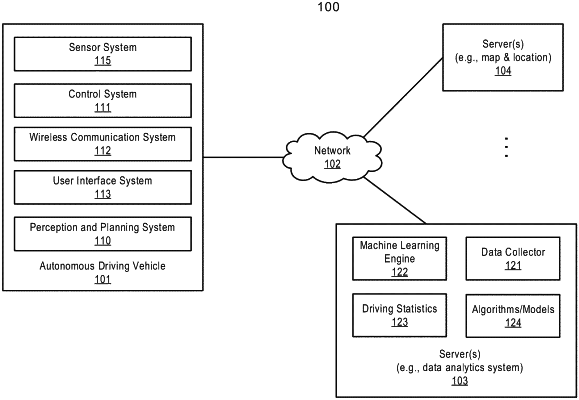| CPC B60W 60/0011 (2020.02) [B60W 30/18018 (2013.01); B60W 30/18027 (2013.01); B60W 30/18109 (2013.01); B60W 30/18159 (2020.02); B60W 30/18163 (2013.01); B60W 60/0018 (2020.02); B60W 2520/04 (2013.01); B60W 2555/60 (2020.02); B60W 2754/10 (2020.02)] | 11 Claims |

|
1. A computer-implemented method for detecting an unexpected control state of an autonomous driving system, the method comprising:
generating environmental data of a vehicle;
determining, by the autonomous driving system, a first control state based on the environmental data;
determining, by a reference model, a second control state based on the environmental data, wherein the reference model defines at least one scenario each corresponding to a plurality of expected control states and a state switching condition, and in each of the expected control states corresponding to the scenario, an action of the vehicle in the scenario obeys a traffic rule;
determining the unexpected control state of the autonomous driving system by comparing the first control state with the second control state;
correcting the autonomous driving system based on the unexpected control state; and
controlling the vehicle based on the corrected autonomous driving system, wherein determining by the reference model the second control state based on the environmental data comprises:
determining a first scenario of the at least one scenario and state switching conditions corresponding to the first scenario based on the environmental data;
determining a current state of the vehicle;
determining a current expected control state of the vehicle based on the environmental data, the first scenario, the current state of the vehicle, and state switching conditions corresponding to the first scenario; and
determining the current expected control state as the second control state, wherein in the first scenario, the vehicle goes into an intersection with a traffic light, and the plurality of expected control states corresponding to the first scenario comprises a driving state, wherein the driving state further comprises a second driving state of approaching a stop line at the intersection and a third driving state of following a lane, and the state switching condition comprises: a first state switching condition that the traffic light turns green, a second state switching condition that the traffic light turns red, a third switching condition that a distance to the stop line at the intersection is smaller than a first preset threshold, and a fourth switching condition that the distance to the stop line at the intersection is smaller than a second preset threshold, and determining the current expected control state of the vehicle based on the environmental data, the first scenario, the current state of the vehicle, and the state switching conditions corresponding to the first scenario comprises:
in response to determining that the distance to the stop line at the intersection is not smaller than the first preset threshold, determining the third driving state of following the lane as the current expected control state of the vehicle; and
in response to determining that the distance to the stop line at the intersection is smaller than the first preset threshold and not smaller than the second preset threshold and the traffic light turns red, determining the second driving state of approaching the stop line at the intersection as the current expected control state of the vehicle.
|